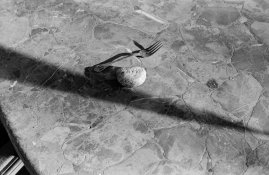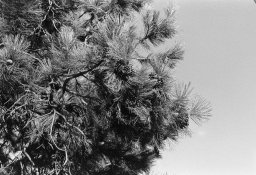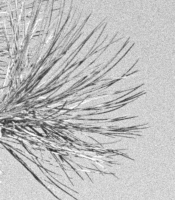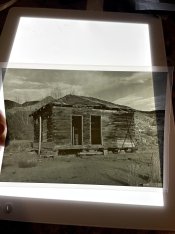Some time ago I mixed quite a bit of 10% glycin-TEA mixture. ie, 80ml of triethanolamine (clear grade, not yellow) and 10g of glycin. Heated it up and stirred with a magnetic stirrer for probably around an hour and eventually it was all incorporated, then I topped to 100ml of total solution with triethanolamine. I mixed this up for other experiments, but it seemed like glycin wasn't what I needed there so I figured I'd try using it as a film developer. The end product is "EXG1". The formula is as so:
* 800ml water (warm if mixing from powdered glycin)
* 20ml Glycin-TEA 10% (otherwise substitute with 20ml of TEA and 2g of glycin, mixed in last)
* 12g of potassium carbonate (I use 60ml of 20% solution for easy mixing)
* top to 1L of water
* Use as soon as possible, when the proper temperature. Activity will change after 6 hours, maybe less. Do not reuse
* Starting point time for unknown films of 11m at 70F with normal agitation
This formula of course is begging to be modified, similar to D-23, and Glycin-TEA is a great mixture to have on hand anyway, since it is probably more stable than the glycin in powder form. One important thing missing here is the complete lack of sulfite. Glycin stays alive a surprisingly long time with absolutely no sulfite, at least if TEA is present. (TEA can scavenge some oxygen, though not nearly as efficiently) I was still getting paper darkening after 2 days of just leaving a bit of glycin-TEA and water in an open beaker. I'm not sure what exactly I'd want to add to this formula as I'm fairly content with it. It can be quite grainy with T-grain films, so an addition of sulfite as a silver solvent might be helpful there, but I rarely use T-grain films so I haven't bothered.
I've tried this with several films and have been especially delighted when using this to push HP5+. The results are definitely not fine grained, but also aren't overly grainy (aside from T-Max 3200), and yields very sharp results. Similar to Rodinal but without the tendency to have clumpy grain, the grain here is much smoother and to my eyes more attractive and natural. One notable thing is that the grain doesn't seem to get bigger with pushing, though it does get more obvious just due to the contrast increase. Overall tonality is full speed shadows, compensated highlights, and normal to raised contrast midtones.
I made two blog posts giving results including some full resolution "real" shots and times, but I'll also attach some example pictures here for the people that don't want to click through
https://grainy.vision/blog/exg1-a-bare-bones-glycin-film-developer
https://grainy.vision/blog/exg1-for-pushing-film
HP5+@1600 (20m development time)



FP4+@125 (11m development time)


T-Max 3200@3200 (20m development time)


FP4+@400 (19m development time)

Acros 100@400 (19m development time)

* 800ml water (warm if mixing from powdered glycin)
* 20ml Glycin-TEA 10% (otherwise substitute with 20ml of TEA and 2g of glycin, mixed in last)
* 12g of potassium carbonate (I use 60ml of 20% solution for easy mixing)
* top to 1L of water
* Use as soon as possible, when the proper temperature. Activity will change after 6 hours, maybe less. Do not reuse
* Starting point time for unknown films of 11m at 70F with normal agitation
This formula of course is begging to be modified, similar to D-23, and Glycin-TEA is a great mixture to have on hand anyway, since it is probably more stable than the glycin in powder form. One important thing missing here is the complete lack of sulfite. Glycin stays alive a surprisingly long time with absolutely no sulfite, at least if TEA is present. (TEA can scavenge some oxygen, though not nearly as efficiently) I was still getting paper darkening after 2 days of just leaving a bit of glycin-TEA and water in an open beaker. I'm not sure what exactly I'd want to add to this formula as I'm fairly content with it. It can be quite grainy with T-grain films, so an addition of sulfite as a silver solvent might be helpful there, but I rarely use T-grain films so I haven't bothered.
I've tried this with several films and have been especially delighted when using this to push HP5+. The results are definitely not fine grained, but also aren't overly grainy (aside from T-Max 3200), and yields very sharp results. Similar to Rodinal but without the tendency to have clumpy grain, the grain here is much smoother and to my eyes more attractive and natural. One notable thing is that the grain doesn't seem to get bigger with pushing, though it does get more obvious just due to the contrast increase. Overall tonality is full speed shadows, compensated highlights, and normal to raised contrast midtones.
I made two blog posts giving results including some full resolution "real" shots and times, but I'll also attach some example pictures here for the people that don't want to click through
https://grainy.vision/blog/exg1-a-bare-bones-glycin-film-developer
https://grainy.vision/blog/exg1-for-pushing-film
HP5+@1600 (20m development time)



FP4+@125 (11m development time)


T-Max 3200@3200 (20m development time)


FP4+@400 (19m development time)

Acros 100@400 (19m development time)








